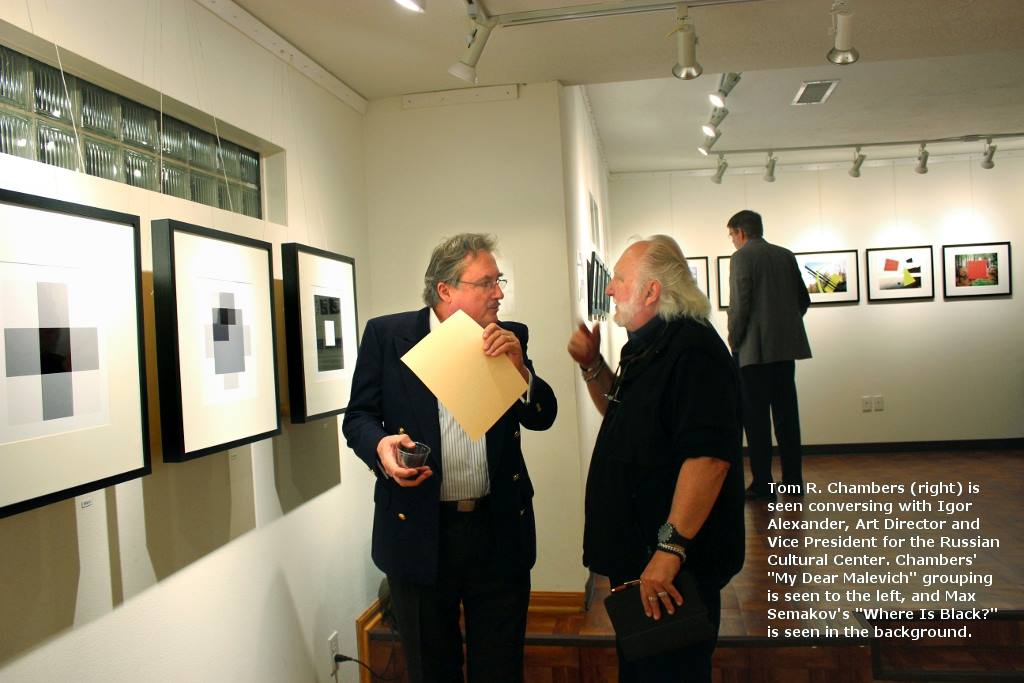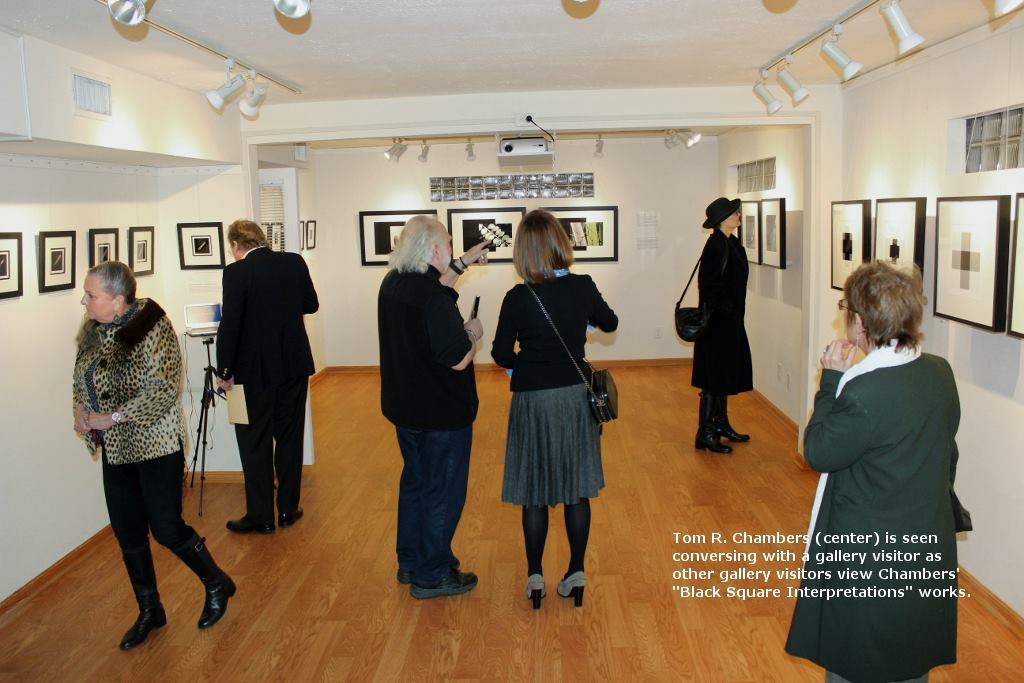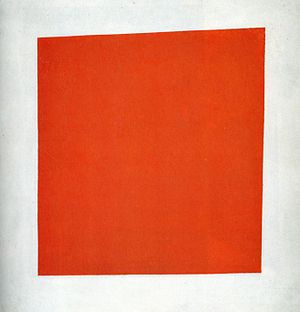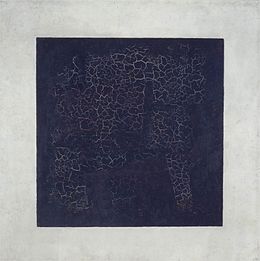Suprematism Exhibitions
SUPREMATISM Exhibitions (Russian Cultural Center, Houston, Texas, 2015/Shapiro Center, Columbia University, New York City, 2015)Tom R. Chambers·Monday, April 23, 201815 ReadsBlack Square Interpretations and Other Suprematist Explorations (two-person show with Max Semakov), CaviArt Gallery, Russian Cultural Center, Houston, Texas, March 6 – April 7, 2015.

Tom R. Chambers and Max Semakov/MiMs Art Group come together to pay tribute to Kazimir Malevich through a series of artworks that interpret his “Black Square”, and explore Suprematism. Chambers is based in Houston, Texas, and Semakov is based in Moscow, Russia, which moves this collaboration to a higher plane of exchange between the citizenry of two countries – America and Russia. Chambers and Semakov through their interpretations and explorations move Suprematism in the direction of Neo-Suprematism. Their artworks accentuate and cultivate non-objectivity – the supremacy of pure feeling in creative art.

“Suprematism Infinity: Reflections, Interpretations, Explorations” (December 1, 2015 – January 22, 2016) showcases works by Tom R. Chambers, Mark Khidekel, Irina Nakhova and Max Semakov. It explores works inspired by the legacy of Suprematism through new forms, styles, media, and technology.
Invented by Kazimir Malevich a century ago, Suprematism became one of the most radical and influential art movements of the 20th century. It brought the Russian avant-garde into a state of absolute non-objectivity, based on “pure feeling.” Suprematism created a perception of multiple dimensions without horizons or boundaries and translated these perceptions into energetic relationships between primary geometrical forms. Suprematism also produced a synthesis that merged exploration of the imagination with revolutionary changes in modern science; it allowed development while embracing science and technology as creative tools.

Tom R. Chambers, an artist and educator of digital/new media art, exhibits a transition from realistic photos to pixel abstractions in his series of pixelscapes, “My Dear Malevich” and “Red Sweep Black Square”. They are part of a larger body of works entitled “Black Square Interpretations and Other Suprematist Explorations.” For Chambers, “Pixelscapes is minimal art in keeping with Malevich’s Suprematism – the feeling of non-objectivity – the creation of a sense of bliss and wonder via abstraction.”
Mark Khidekel explores the Suprematist form-creation principles through his career as an architect, designer, and artist. Khidekel has produced many multi-functional projects, including his Post-Suprematist design for the St. Petersburg Russian Museum’s Depository and innovative environmental projects in Russia and the US such as Ostrov (1970s) and Bridge-city (2008-2014). These continue the visionary and environmental legacy of futuristic projects from the 1920s.
Irina Nakhova, the first female artist to represent Russia at the Venice Biennale, will display a digital documentation of part of her Green Pavilion’s “total environments,” which according to The Guardian was one of “the best 5 pavilions” of Venice Biennale 2015. Her discovery of the liberating power of Suprematism in the early 1980s allowed Nakhova to abstract herself from the Soviet reality and create a new artistic environment in her own apartment. It became one of the seminal projects of Moscow conceptualism and Nakhova’s site-specific environmental art. Nakhova’s “Malevich’s Cube,” is the focal point of her “time machine”. Marked by three lightening squares the black room is “the axis of past, present and future.” Space, light, colors, and video imagery create an experience that is both emotionally charged and engaging for the viewer. In Nakhova’s words, the black cube represents a “strange, mysterious, unpredictable Russia.”
Max Semakov, a photographer and artist, exhibits his series “Where is Black?” that injects colored planes into ordinary landscapes in the search for the point of transition to the Suprematist universe. His project “Suprematist Park” is inspired by Suprematist architectons transformed into elements of recreational architecture.
Chambers and Semakov, who share similar aspirations, produce works that have similarities in method or intent to earlier Suprematist pieces, but make use of digital/new media, resulting in the hybridization of the non-objective form.The issues of nature, space and the environment remain cornerstones of contemporary discourse. It is through Suprematism that these issues can be discussed emotionally and creatively. The “blissful sense of liberation” experienced by Malevich can be found in a legacy that continues to encourage the emergence of new ways to create and interpret art.
Curator: Regina Khidekel.Tom R. Chambers donated his works, “My Dear Malevich” and “Red Sweep Black Square” to the Russian American Cultural Center (RACC) Art Collection, New York City.
This exhibition is in conjunction with the “100 Years of Suprematism” conference, Shapiro Center, Columbia University, New York City, December 11 – 12, 2015. It is organized in celebration of the centenary of Kazimir Malevich’s invention of Suprematism and the first public display of his Suprematist paintings in December, 1915. The two-day conference is organized in association with the Harriman Institute, the Lazar Khidekel Society, and SHERA. It features presentations by an international and renowned group of scholars. Among them are leading researchers in the field from the United States, Russia, and the United Kingdom. The event includes a presentation of “Kazimir Malevich: Letters and Documents, Memoirs and Criticism” (London: Tate, 2015)


Red Sweep Black Square
This project is a video re: Kazimir Malevich‘s “Black Square” and “Red Square”, both exhibited in 1915. They approximate being one and the same, but Malevich considered his “Black Square” to be the true icon – its zero form – for Suprematism. In Malevich’s system, the movement from black-and-white Suprematism to colored and finally to white Suprematism was indicated by three squares: a black, a red, and a white one. (Vitebsk, Aleksandra Shatskikh, 2007 [1917-1922])
The first time Malevich exhibited his “Red Square”, in 1915, it was subtitled “Pictorial Realism of a Peasant in Two Dimensions”. During the Vitebsk years, the representation of the “Red Square” was politicized. Lazar Lissitzky had a hand in this Bolshevization of the Suprematist figure. He turned the “Red Square” into the Unovis seal. However, Malevich and all the other Suprematist-Unovis members deemed the “Black Square” to be the true symbol of Unovis. (Vitebsk, Aleksandra Shatskikh, 2007 [1917-1922])
In the video below, the sweeping of the color red acknowledges “Red Square” as a Suprematist figure, but there is always a return to the true icon, “Black Square” for Suprematism. Click on player to view.



